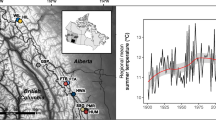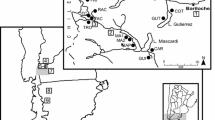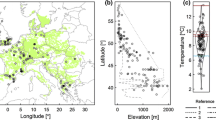Abstract
It has long been hypothesized that trees growing at range limits likely also occur near the limit of their ecological amplitude and thus, should be more sensitive to climate variability than individuals growing nearer the range core. We developed a tree-ring chronology using Tsuga canadensis individuals from three disjunct stands at the species’ southern limit to quantify the influence of climate and disturbance on radial growth patterns. The tree-ring record extended 158 years from 1850 to 2007. Significant negative relationships were found between the STANDARD chronology and monthly mean temperature, monthly maximum temperature, and monthly minimum temperature during the previous and current summer, while significant positive relationships were documented between the STANDARD chronology and monthly minimum temperature for September and October of the current year. Also, significant positive relationships were documented between the STANDARD chronology and monthly total precipitation for September of the previous year and May of the current year. Response function analysis showed that monthly climate variables (r 2 = 0.22) and prior growth (r 2 = 0.40) explained 62% of the variance in the T. canadensis tree-ring chronology. A time series plot for the T. canadensis chronology showed that actual tree growth agreed relatively well with the predicted growth based on significant climate variables. However, positive departures from the predicted growth were noted. Dendroecological analysis revealed these departures were likely related to disturbance events. Our results indicated that T. canadensis individuals at its southernmost extent are sensitive to regional climate, but not more so than trees nearer the range core. We hypothesize that microenvironmental conditions of T. canadensis stands at its southern limit are similar to conditions within the contiguous distribution of the species, which may explain this pattern.








Similar content being viewed by others
References
Abrams MD, van de Gevel SL, Dodson RC, Copenheaver CA (2000) The dendroecology and climatic impacts for old-growth white pine and hemlock on the extreme slopes of the Berkshire Hills, Massachusetts, USA. Can J Bot 78:851–861
Adams MS, Loucks OL (1971) Summer air temperature as a factor affecting net photosynthesis and distribution of eastern hemlock (Tsuga Canadensis L. (Carriere)) in southwestern Wisconsin. Am Mid Nat 85:1–10
Avery GS Jr, Creighton HB, Hock CW (1940) Annual rings in hemlocks and their relation to environmental factors. Am J Bot 27:825–831
Black BA, Abrams MD (2004) Development and application of boundary-line release criteria. Dendrochronologia 22:31–42
Black BA, Abrams MD (2005) Disturbance history and climate response in an old-growth hemlock-white pine forest, central Pennsylvania. J Torrey Bot Soc 132:103–114
Blasing TJ, Duvick DN, West DC (1981) Dendroclimatic calibration and verification using regionally averaged and single station data. Tree-Ring Bull 41:37–43
Blasing TJ, Stahle DW, Duvick DN (1988) Tree ring-based reconstruction of annual precipitation in the southcentral United States from 1750 to 1980. Water Resour Res 24:163–171
Bormann FH, Platt RB (1958) A disjunct stand of hemlock in the Georgia Piedmont. Ecology 39:16–23
Brown JH (1984) On the relationship between abundance and distribution of species. Am Nat 124:255–279
Brown JH, Mehlman DW, Stevens GC (1995) Spatial variation in abundance. Ecology 76:2028–2043
Catovsky S, Holbrook NM, Bazzaz FA (2002) Coupling whole-tree transpiration and canopy photosynthesis in coniferous and broad-leaved tree species. Can J For Res 32:295–309
Chhin S, Wang GG, Tardif J (2004) Dendroclimatic analysis of white spruce at its southern limit of distribution in the Spruce Woods Provincial Park, Manitoba, Canada. Tree-Ring Res 60:31–43
Cleaveland MK, Cook ER, Stahle DW (1992) Secular variability of the southern oscillation detected in tree-ring data from Mexico and the southern United States. In: Diaz HG, Markgraf V (eds) El Niño: historical and paleoclimatic aspects of the southern oscillation. Cambridge University Press, Cambridge, pp 271–291
Cook ER (1985) A time-series analysis approach to tree-ring standardization. PhD Dissertation, University of Arizona, Tucson
Cook ER, Cole J (1991) On predicting the response of forests in eastern North America to future climate change. Clim Change 19:271–282
Cook ER, Jacoby GC (1977) Tree-ring–drought relationships in the Hudson Valley, New York. Science 198:399–401
Cook ER, Kablack MA, Jacoby GC (1988) The 1986 drought in the southeastern United States: how rare an event was it? J Geophys Res 93:14257–14260
Cook ER, Stahle DW, Cleaveland MK (1995) Dendroclimatic evidence of the North Atlantic Oscillation using tree-ring chronologies from North American and Europe. Holocene 8:9–17
Cook ER, Glitzenstein JS, Krusic PJ, Harcombe PA (2001) Identifying functional groups of trees in west Gulf Coast forests (USA): a tree-ring approach. Ecol Appl 11:883–903
Cox CB, Moore PD (2000) Biogeography: an ecological and evolutionary approach, 6th edn. Blackwell Science, Malden
D’Arrigo RD, Schuster WSF, Lawrence DM, Cook ER, Wiljanen M, Thetford RD (2001) Climate-growth relationships of eastern hemlock and chestnut oak from Black Rock Forest in the highlands of southeastern New York. Tree-Ring Res 57:183–190
Dai A, Trenberth KE (1998) Global variations in droughts and wet spells: 1900–1995. Geophys Res Lett 25:3367–3370
Daly C, Neilson RP, Phillips DL (1994) A statistical-topographic model for mapping climatological precipitation over mountainous terrain. J Appl Meteor 33:140–158
Daly C, Gibson WP, Taylor GH, Johnson GL, Pasteris P (2002) A knowledge based approach to the statistical mapping of climate. Clim Res 22:99–113
Davis MB, Parshall TE, Ferrari JB (1996) Landscape heterogeneity of hemlock-hardwood forest in northern Michigan. In: Davis MB (ed) Eastern old-growth forests. Island Press, Washington, pp 291–304
DeSelm HR, Sherman MD (1982) Species diversity and site position at Savage Gulf, Cumberland Plateau, Tennessee. In: Muller RN (ed) Proceedings of the fourth central hardwood conference. University of Kentucky, Lexington, pp 356–366
DeWitt E, Ames M (1978) Tree-ring chronologies of eastern North America. Laboratory of tree-ring research, Chronology series IV, vol 1, University of Arizona, Tucson
Eastern OLDLIST (2009) Eastern OLDLIST: a database of maximum tree ages of eastern North America. http://people.eku.edu/pedersonn/OLDLISTeast/
Ellison AM, Bank MS, Clinton BD, Colburn EA, Elliott K, Ford CR, Foster DR, Kloeppe BD, Knoepp JD, Lovett GM, Mohan J, Orwig DA, Rodenhouse NL, Sobczak WV, Stinson KA, Stone JK, Swan CM, Thompson J, Von Holle B, Webster JR (2005) Loss of foundation species: consequences for the structure and dynamics of forested ecosystems. Front Ecol Environ 3:479–486
Finzi AC, Canham CD, van Breeman N (1998) Canopy tree-soil interactions within temperate forests: species effects on pH and cations. Ecol Appl 8:447–454
Ford CR, Vose JM (2006) Eastern hemlock transpiration: patterns, controls, and implications for its decline in southern Appalachian forests. In: Second interagency conference on research in the watersheds, 16–18 May 2006. USDA forest service southern research station, Coweeta hydrologic laboratory, pp 181–187
Foster TE, Brooks JR (2001) Long-term trends in growth of Pinus palustris and Pinus elliottii along a hydrological gradient in central Florida. Can J For Res 31:1661–1970
Foster DR, Zebryk TM (1993) Long-term vegetation dynamics and disturbance history of a Tsuga-dominated forest in New England. Ecology 74:982–998
Fritts HC (1971) Dendroclimatology and dendroecology. Quat Res 1:419–449
Fritts HC (1976) Tree rings and climate. Academic Press, London
Fritts HC, Shashkin AV (1994) Modeling tree-ring structure as related to temperature, precipitation, and day length. In: Lewis TE (ed) Tree rings as indicators of ecosystem health. CRC Press, Boca Raton, pp 17–57
Fritts HC, Swetnam TW (1989) Dendroecology: a tool for evaluating variations in past and present forest environments. Adv Ecol Res 19:111–188
Gaston KJ (2003) The structure and dynamics of geographic ranges. Oxford University Press, Oxford
Gaudinski JB, Torn MS, Riley WJ, Swanston C, Trumbore SE, Joslin JD, Majdi H, Dawson TE, Hanson PJ (2009) Use of stored carbon reserves in growth of temperate tree roots and leaf buds: analyses using radiocarbon measurements and modeling. Global Change Biol 15:992–1014
Godman RM, Lancaster K (1990) Tsuga canadensis. In: Burns RM, Honkala BH (eds) Silvics of North America: vol 1, agricultural handbook 654. USDA Forest Service, Washington
Grissino-Mayer HD (1995) Tree-ring reconstructions of climate and fire history at El Malpais National Monument, New Mexico. PhD Dissertation, University of Arizona, Tucson
Grissino-Mayer HD (2001a) Evaluating crossdating accuracy: a manual and tutorial for the computer program COFECHA. Tree-Ring Res 57:205–221
Grissino-Mayer HD (2001b) FHX2–Software for analyzing temporal and spatial patterns of fire regimes from tree rings. Tree-Ring Res 57:115–124
Grissino-Mayer HD (2003) A manual and tutorial for the proper use of an increment borer. Tree-Ring Res 59:3–10
Grissino-Mayer HD, Butler DR (1993) Effects of climate on growth of shortleaf pine (Pinus echinata Mill.) in northern Georgia: a dendroclimatic study. Southeast Geogr 33:65–81
Grissino-Mayer HD, Fritts HC (1995) Dendroclimatology and dendroecology in the Pinaleño Mountains. In: Hoffman R, Istock C (eds) Storm over a mountain island: conservation biology and the Mount Graham affair. University of Arizona Press, Tucson, pp 100–120
Grissino-Mayer HD, Rosenberger MS, Butler DR (1989) Climatic response in tree rings of loblolly pine from north Georgia. Phys Geogr 10:32–43
Hadley JL (2000) Understory microclimate and photosynthetic response of saplings in an old-growth eastern hemlock (Tsuga canadensis L.) forest. Ecoscience 7:66–72
Harper RM (1952) Hemlock in Alabama: a supplementary note. Ecology 33:1128–1129
Hart JL, Grissino-Mayer HD (2008) Vegetation patterns and dendroecology of a mixed hardwood forest on the Cumberland Plateau: implications for stand development. For Ecol Manag 255:1960–1975
Hart JL, Shankman D (2005) Disjunct eastern hemlock (Tsuga canadensis) stands at its southern range boundary. J Torrey Bot Soc 132:602–612
Henderson JP, Grissino-Mayer HD (2009) Climate-tree growth relationships of longleaf pine (Pinus palustris Mill.) in the Southeastern Coastal Plain, USA. Dendrochronologia 27:31–43
Hengeveld R (1990) Dynamic biogeography. Cambridge University Press, Cambridge
Hodges JD, Scott DRM (1968) Photosynthesis in seedlings of six conifer species under natural environmental conditions. Ecology 49:397–981
Holmes RL (1983) Computer assisted quality control in tree-ring dating and measurement. Tree-Ring Bull 43:69–78
Kavanagh K, Kellman M (1986) Performance of Tsuga canadensis (L.) Carr. at the centre and northern edge of its range: a comparison. J Biogeogr 13:145–157
Kelty MJ (1986) Development patterns in two hemlock-hardwood stands in southern New England. Can J For Res 16:885–891
Kessell SR (1979) Adaptation and dimorphism in eastern hemlock, Tsuga canadensis (L.). Carr Am Nat 113:333–350
Kozlowski TT (1979) Tree growth and environmental stresses. University of Washington Press, Seattle
Kozlowski TT, Pallardy SG (1997) Physiology of woody plants, 2nd edn. Academic Press, San Diego
Lacefield J (2000) Lost worlds in Alabama rocks: a guide to the state’s ancient life and landscapes. Alabama Geological Society, University of Alabama Press, Tuscaloosa
Lovett GM, Weathers KC, Arthur MA, Schultz JC (2004) Nitrogen cycling in a northern hardwood forest: do species matter? Biogeochemistry 67:289–308
Lovett GM, Canham CD, Arthur MA, Weathers KC, Fitzhugh RD (2006) Forest ecosystem response to exotic pests and pathogens in eastern North America. Bioscience 56:395–405
Murphy HT, VanDerWal J, Lovett-Doust J (2006) Distribution of abundance across the range of eastern North American trees. Global Ecol Biogeogr 15:63–71
National Climatic Data Center (NCDC) (2009) US Department of commerce, National oceanic and atmospheric administration, Asheville, North Carolina. http://www.ncdc.noaa.gov
Nowacki GJ, Abrams MD (1997) Radial-growth averaging criteria for reconstructing disturbance histories from presettlement-origin oaks. Ecol Monogr 67:225–249
Oosting HJ, Hess DW (1956) Microclimate and a relic stand of Tsuga canadensis in the lower Piedmont of North Carolina. Ecology 37:28–39
Orvis KH, Grissino-Mayer HD (2002) Standardizing the reporting of abrasive papers used to surface tree-ring samples. Tree-Ring Res 58:47–50
Orwig DA, Foster DR, Mausel DL (2002) Landscape patterns of hemlock decline in New England due to the introduced hemlock woolly adelgid. J Biogeogr 29:1475–1487
Pederson N, Cook ER, Jacoby GC, Peteet DM, Griffin KL (2004) The influence of winter temperatures on the annual radial growth of six northern margin tree species. Dendrochronologia 22:7–29
Quarterman E, Turner BH, Hemmerly TE (1972) Analysis of virgin mixed mesophytic forests in Savage Gulf, Tennessee. Bull Torrey Bot Club 99:228–232
Rankin WT, Tramer EJ (2002) Understory succession and the gap regeneration cycle in a Tsuga canadensis forest. Can J For Res 32:16–23
Rogers RS (1978) Forests dominated by hemlock (Tsuga canadensis): distribution as related to site and postsettlement history. Can J Bot 56:843–854
Rubino DL, McCarthy BC (2004) Comparative analysis of dendroecological methods used to assess disturbance events. Dendrochronologia 21:97–115
Sagarin RD, Gaines SD (2002) The ‘abundant centre’ distribution: to what extent is it a biogeographic rule? Ecol Lett 5:137–147
Scurfield G (1973) Reaction wood: its structure and function. Science 179:647–655
Segars CB, Crawford LC, Harvill AM (1951) The occurrence and distribution of hemlock in Alabama. Ecology 32:149–151
Shankman D, Hart JL (2007) The fall line: a physiographic forest vegetation boundary. Geogr Rev 97:502–519
Stahle DW, D’Arrigo RD, Krusic PJ, Cleaveland MK, Cook ER, Allan RJ, Cole JE, Dunbar RB, Therrell MD, Gay DA, Moore MD, Stokes MA, Burns BT, Villanueva-Diaz J, Thompson LG (1998) Experimental dendroclimatic reconstructions of the Southern Oscillation. Bull Am Meteorol Soc 79:2137–2152
Stokes MA, Smiley TL (1996) An introduction to tree-ring dating. University of Arizona Press, Tucson
Webb SL, Glenn MG, Cook ER, Wagner WS, Thetford RD (1993) Range edge red spruce in New Jersey, USA: bog versus upland population structure and climate responses. J Biogeogr 20:63–78
Yamaguchi DK (1991) A simple method for cross-dating increment cores from living trees. Can J For Res 21:414–416
Acknowledgments
We thank Matthew Kachelman for assistance with field data collection and sample preparation and Lucrecia Martinez for assistance in the laboratory. We also thank the contributors of Tsuga canadensis chronologies to the International Tree-Ring Data Bank, especially Edward Cook and Neil Pederson for their updated Savage Gulf Natural Area data. This manuscript was much improved by comments from Steven Leavitt and two anonymous reviewers.
Author information
Authors and Affiliations
Corresponding author
Additional information
Communicated by S. Leavitt.
Rights and permissions
About this article
Cite this article
Hart, J.L., van de Gevel, S.L., Sakulich, J. et al. Influence of climate and disturbance on the growth of Tsuga canadensis at its southern limit in eastern North America. Trees 24, 621–633 (2010). https://doi.org/10.1007/s00468-010-0432-y
Received:
Revised:
Accepted:
Published:
Issue Date:
DOI: https://doi.org/10.1007/s00468-010-0432-y




